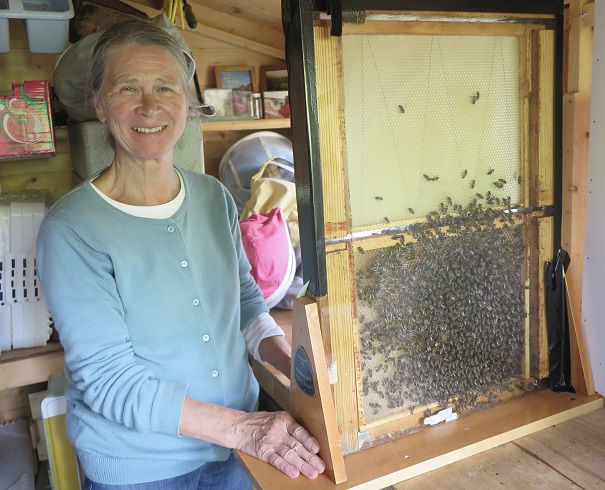
We’ve had some really hot weather (at least for us) over the past week with the temperature reaching at least 26 degrees Celsius some days. The lime trees are in full bloom and I can smell their glorious perfume on my walk to collect eggs from the local farm. The bees have all been left to get on with things and a box of sections is being worked by my strongest colony. I can peep in and watch progress through the see through cover board.
Having told you last week that I don’t garden much, my professional gardener friend Mary came up from Dundee for a few days and was not very impressed by my “no gardening” garden strategy. First we visited the local garden centre for potting compost, and a couple of bee friendly outdoor plants, and gave my house plants a makeover. We brought them all out outside to repot and they do look much better. I’ve been given instructions on caring for an orchid properly so I know now only to water it when the roots are white. The orchid was a special gift but I feel it’s quite a responsibility considering I accidentally killed the last one I bought a few years ago.

Mary thought I’d kept some plants prisioner in pots too long so, over copious tea and scones, we discussed our action plan for weeding and planting out the hebe and sedum: she was very tactful. We were sitting out front, in the rocker and new recycled wooden deck chair from Wastebusters Forres (£6), and I got distracted by an amazing sight a few feet away. At first I thought I was seeing a bright green dragonfly hovering around the trolley.
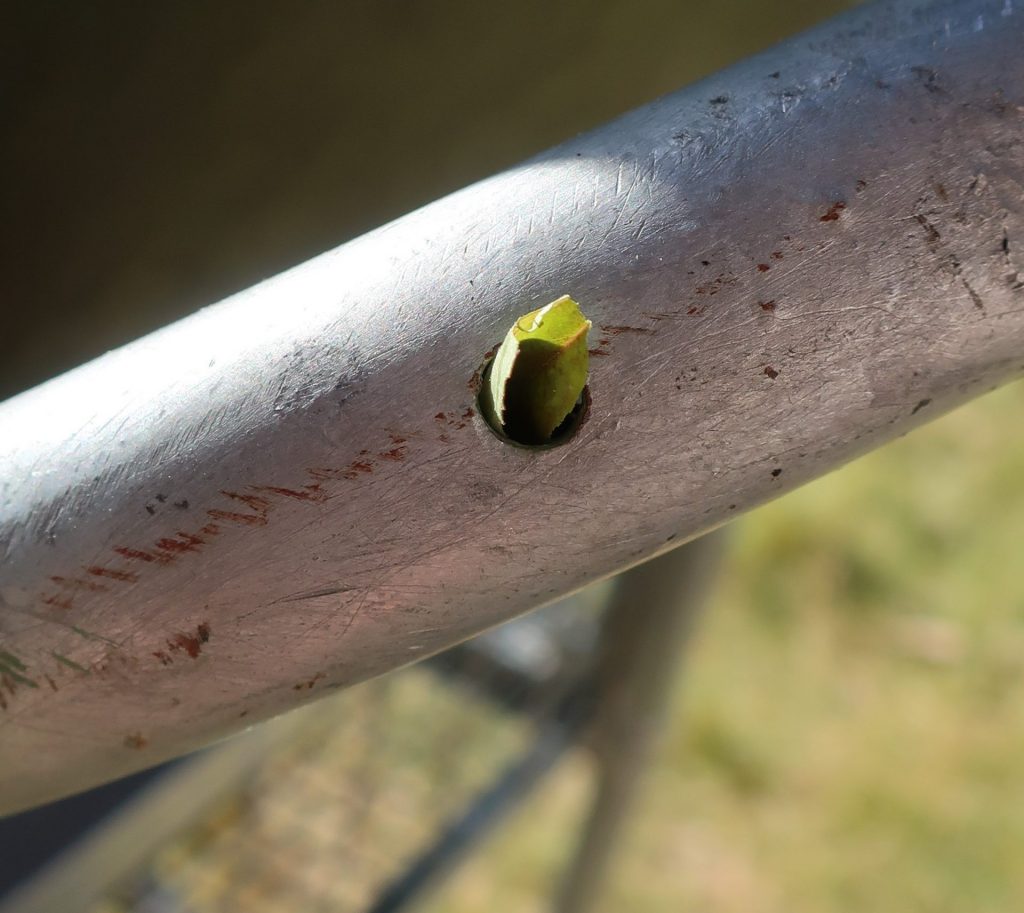
On closer examination, I saw a leaf disappearing down into the tubular handle of the garden trolley that currently holds the solar wax extractor to make moving it into the sun’s dazzling rays easier. Then it dawned on me!
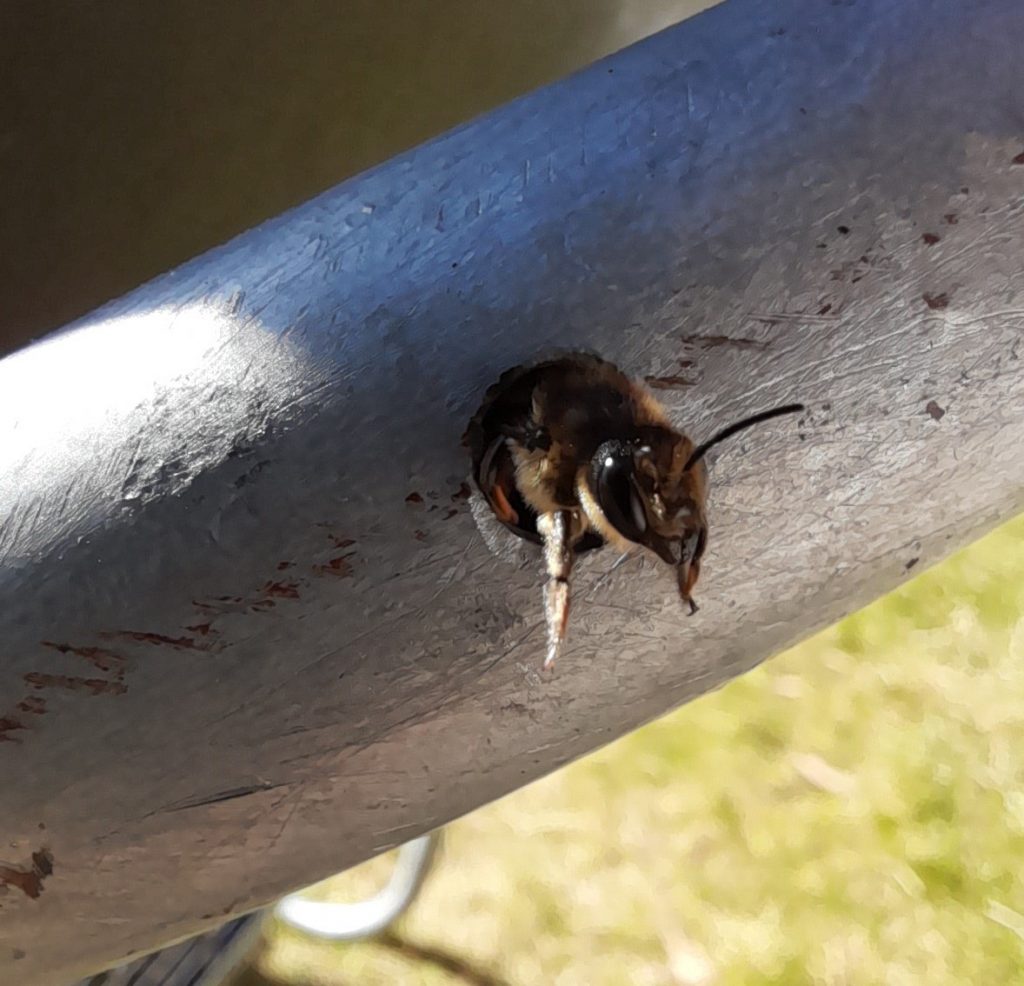
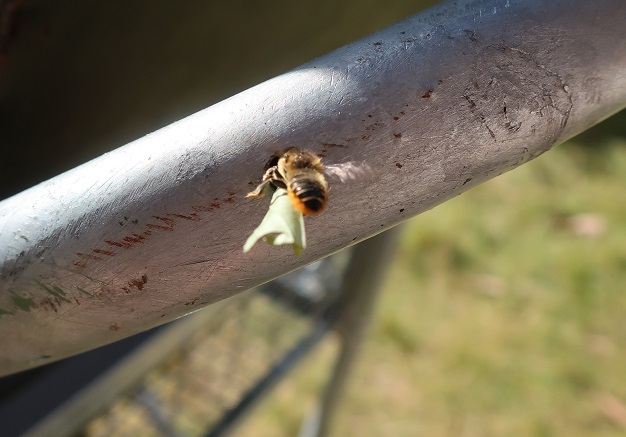
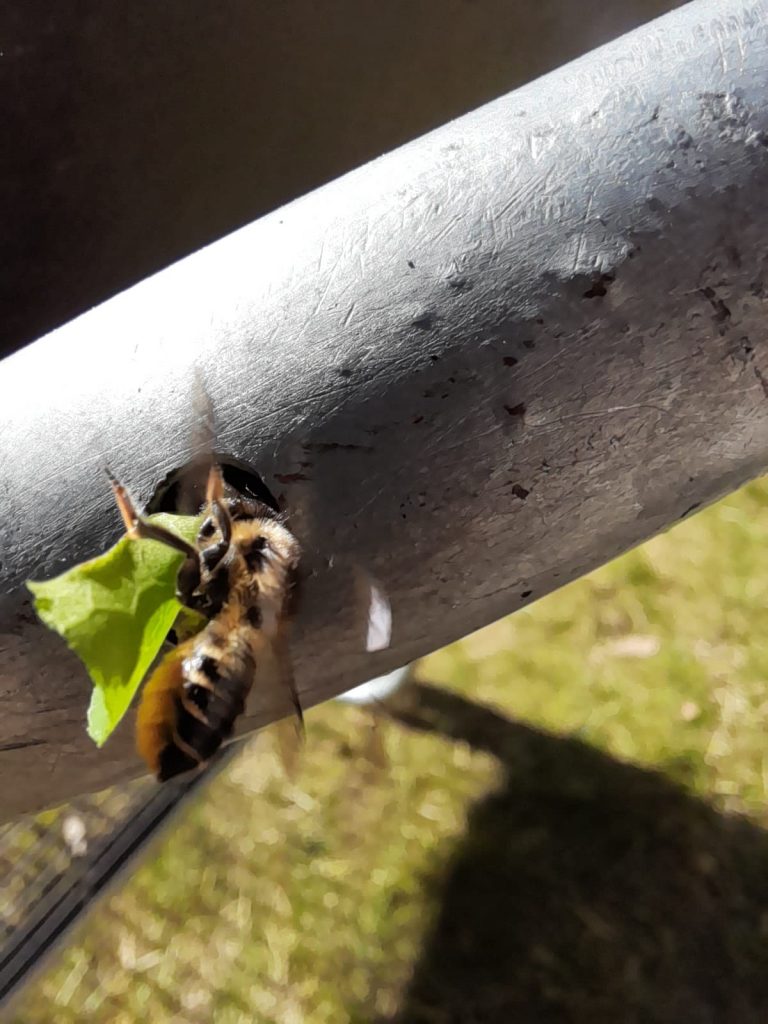

I’ve never seen a leafcutter bee before but there are a couple of species in the north and this might be Megachile willughobiella, or Willughby’s leafcutter bee, from the family Megachilidae family of solitary bees.They feed on various plants including everlasting peas, bellflowers, brambles, and willowherbs of which there are plenty in this garden. They are also versatile nesters and have been found in rubber garden hoses and folded garden parasols which fits in with the whacky choice of home here. I realise that the wax extractor shades the trolley handle from heating in the sun but the metal seems not to heat up anyway which is fortunate for the bee. This bee has had no difficulties navigating to the different locations of the trolley as I move it a few feet to catch the sun.
I wasn’t successful at videoing this one but I did sit in the hot sun for nearly an hour getting these shots to share with you. It took, on average, between 8-14 minutes for each trip out to collect leaves. The bee will cut the leaf to size with its mandibles before flying home heavily laden.
Observation Hive Goings On.
It’s been 36 days since Stephen McCarthy and I installed the small swarm with virgin queen on the 9th of June. I’ve fed them more or less continually to support the small colony and help them get the new top frame of foundation drawn out, and some food stored.

This is the top frame on the front side which faces the door and front of the shed. The back side of the hive is always busier with bees but it is harder to photograph due to darkness and not much space to move about.
I spotted the queen the day after they took up residence and she appeared to have a retinue and be laying eggs 2 days later, but this was not the case. I saw no eggs till 24th June which was 15 days after setting up. On the 13th June, I saw the queen running on the comb looking quite harassed as if she couldn’t find her way out. I saw her leave the entrance at 14:30 hours and the bees fanning at the entrance. It was not a great day really as quite overcast though 16.4 degrees C in the shade. The sun was trying to push its way out. Later in the day, I noticed the queen calmly moving around on the comb but without a retinue. She probably went out again on 16th June which was a perfect mating day at 19 degs C and warm and humid. I think this because I couldn’t find her for a couple of hours and there was unusual excitement and activity on the comb during that time. On the 20th June she had a retinue and I saw her backing into cells after peering inside on 23rd June, though there were no eggs to be seen till next day on 24th.
Chalkbrood.
On the 26th June the queen had laid up large areas of front and back bottom frame and the weather was good till the 30th June when heavy rain fell for 5 days. On day 30, the 8th July, I was dismayed to find the bees clearing out lots of white chalkbrood mummies. Some were black indicating fruiting bodies and that the spores were being released. Even worse, the bees had ground some down to a grey powder on the floor. I refilled the feeder lickety split to help them generate some heat. The shed was cooler during the week of rain making me realise that I need to think of a way to keep this little colony warm enough over winter if they are to stay in the shed without perishing. Amazingly, next day there was not a trace of the chalbrood which had been cleared out. There was no evidence of any directly below the entrance to the hive outside the shed either, so I would have missed it if I had not been watching the hive every day. The empty cells would have been a mystery though.
Where’s The Queen?
On the 10th July, 2 days after the chalkbrood appeared, the queen disappeared. 6 “play” cups were forming on the front of the brood frame. As soon as I removed the insulated cover board from the outer hive wall, I noticed the change in tempo. The wee colony roared increasing in volume till I darkened them again. They were running on the frame in a frenzy. Later in the day they were calmer but backfilling the now empty cells in the middle of the frame with nectar. The queen cup on the right was being extended. Next day (11th July) it was clear that they were superseding the queen and getting 2 queen cells ready. By 5pm the right hand cell was sealed and at 7pm the one on the left was also sealed. On 12th July both queen cells were being worked on but the one on the right was more sculpted that the other and was longer at 2.0 cm compared with 1.5cm on the left. By the 14th July, all play cups had been removed and the 2 queen cells were sculpted and more dimpled. They were covered in bees making photography difficult. Later in the day when it was warmer the frame was quieter and I took more pictures and noticed that a bee on the right hand cell was vibrating the cell using the DVAV signal (doro ventral abdominal vibration) which confirms my thoughts that this will be the cell containing the next queen and that the other will be the insurance policy. We shall see on 19th July when I shall be glued to the obs hive.
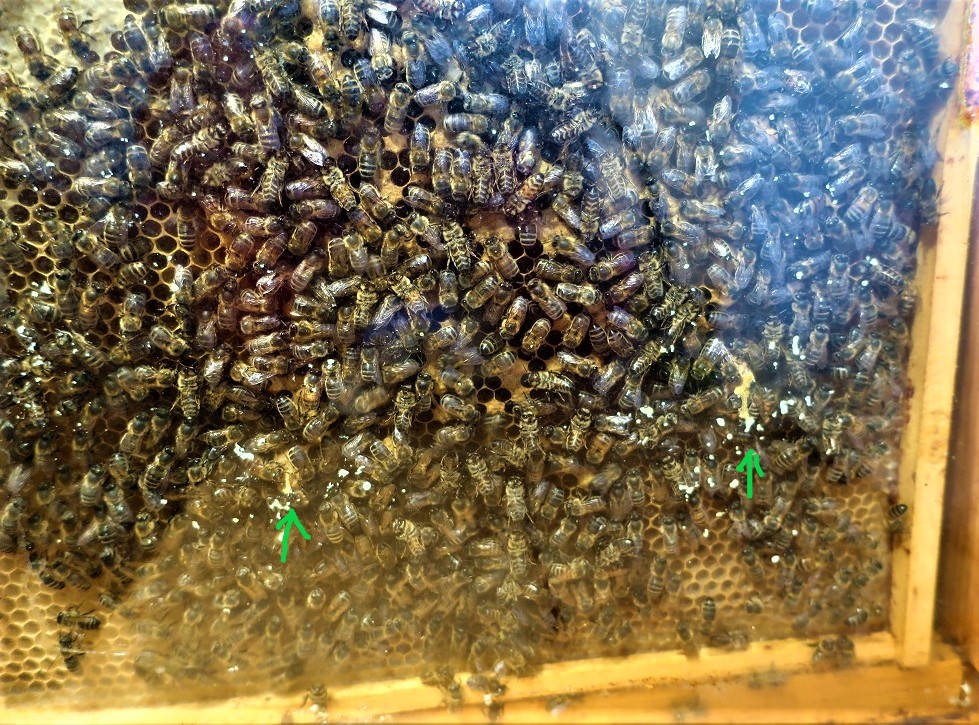
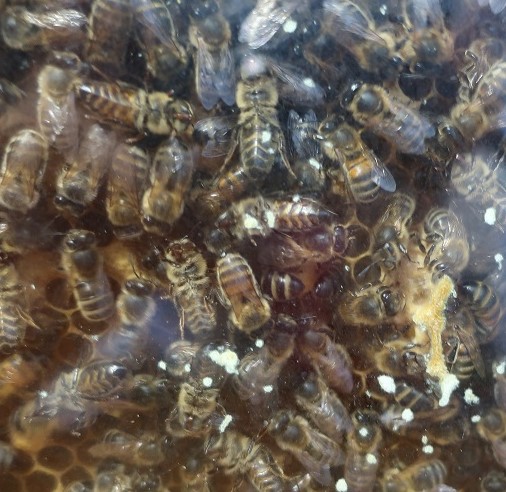
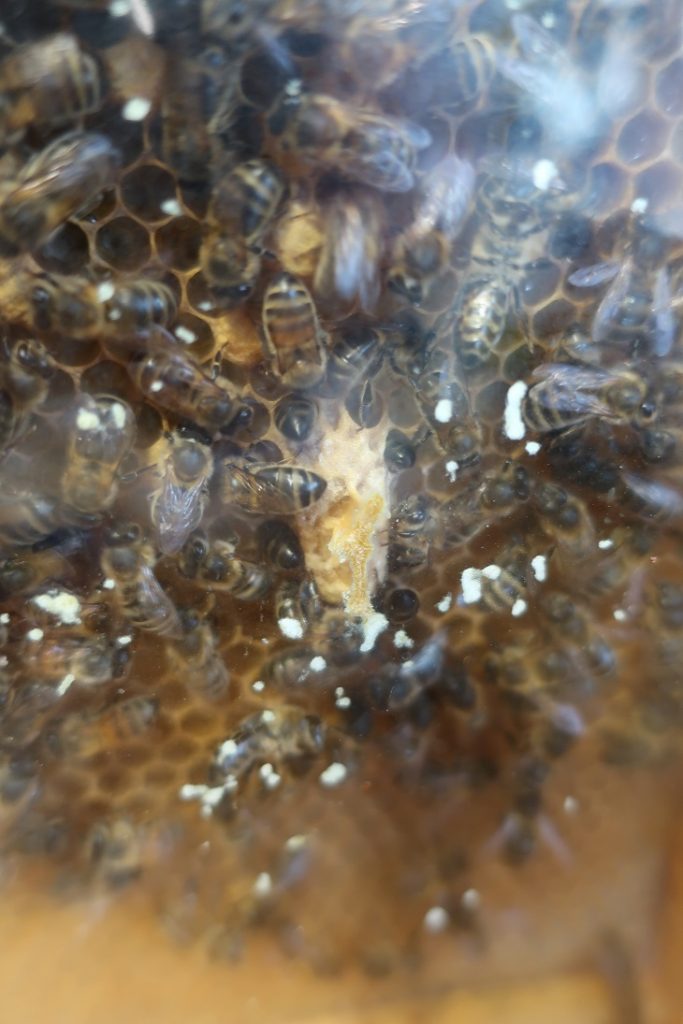
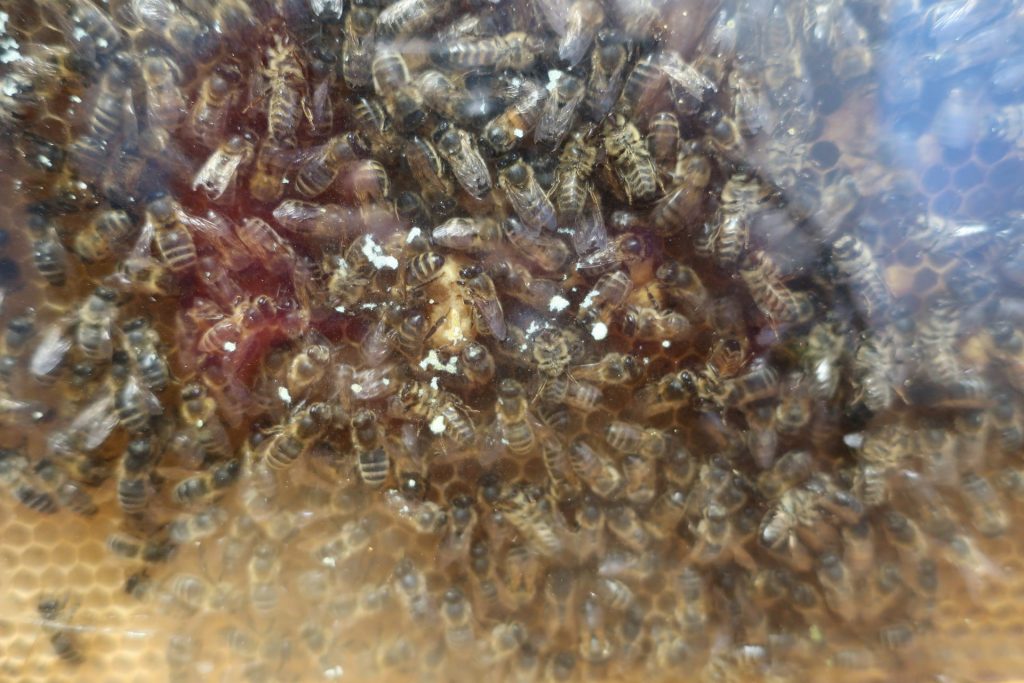
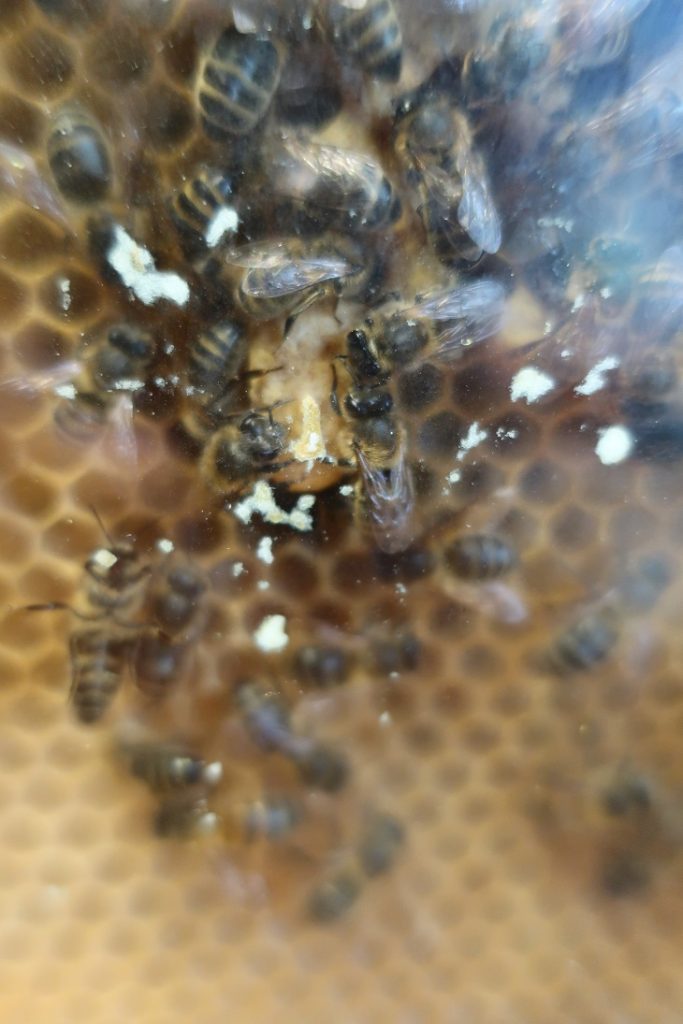
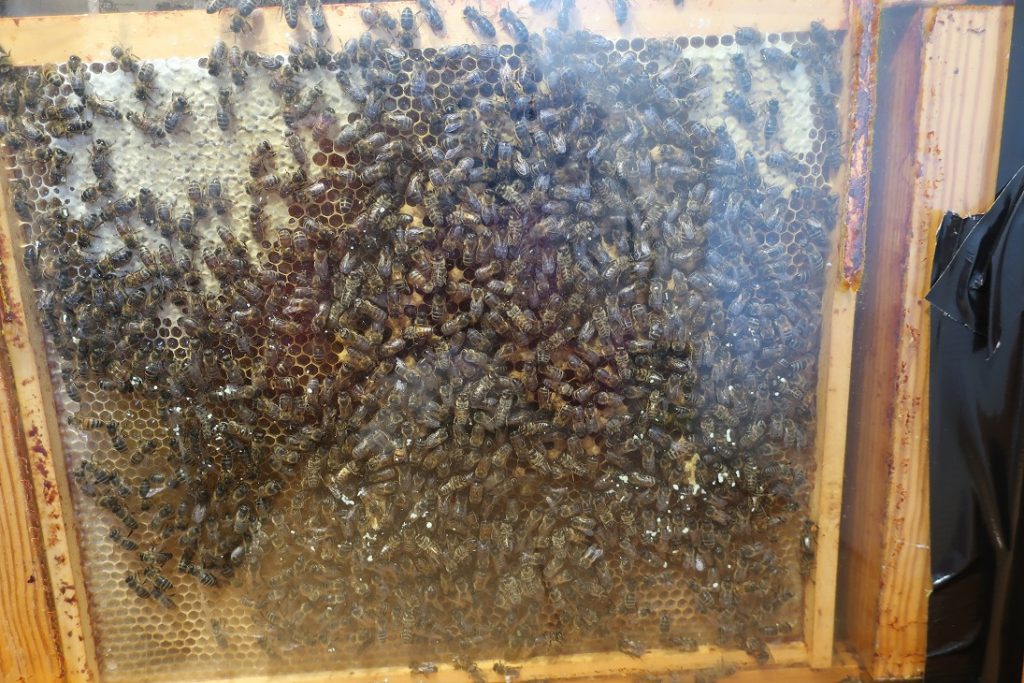
The First Queen Laying.
Youtube video of newly mated queen laying her first eggs
Supersedure.
So, this is a case of supersedure with 2 queen cells only and they are closer to the bottom of the frame than the top. The weather was not too bad around mating time but something has made the colony reject the queen and make a new one before the end of the season. This is happening in 2 other full sized colonies in this apiary. I found the bees balling something in the grass a few weeks ago and figured that the wasps must be starting to hunt earlier. On closer examination though I saw they were removing a newly mated large and lovely looking queen from their hive. This was the first time that I had seen her and I had not opened the hive since swarm control a month before.
The queen was not dead when I picked her up but she had a damaged leg and died soon afterwards. I put on a glove and smeared her over a low hanging bough in the plum tree to create a swarm “post” or place to bivouac next season.
I’m not expecting any more swarms this season and I’m leaving the bees to get on with making honey. I shall monitor varroa levels at the end of July, and check that the queens are laying at the end of August. I’ll not be marking any new queens till next spring now in case they supersede at a time when mating may get more challenging.

You are amazing, Ann, following up all these activities and writing about them for us too. I’m sure you will have inspired lots of other beekeepers to get an observation hive now. Thank you for another fascinating blog.
Bravo !
Another great article
Thank you, Gino. Glad you enjoyed it.
Very interesting, to have seen several colonies superseding newly mated queens. I suspect the workers in these had sensed (somehow) that their queens were not good enough and had decided to replace them. Thank you for reporting that workers performed the DVAV signal on queen cells. I did not know that this “Get going!”signal is used in this context.
We have had some spells of poor mating weather such as 5 days of continuous rain. According to work by Scneider (quoted by Tarpy), the more DVAV signals on a QC the more likely that this would be a successful queen. Interestingly, I have not seen much mote activity on the obs hive larger QC that looks the better formed. The queens have not emerged yet.